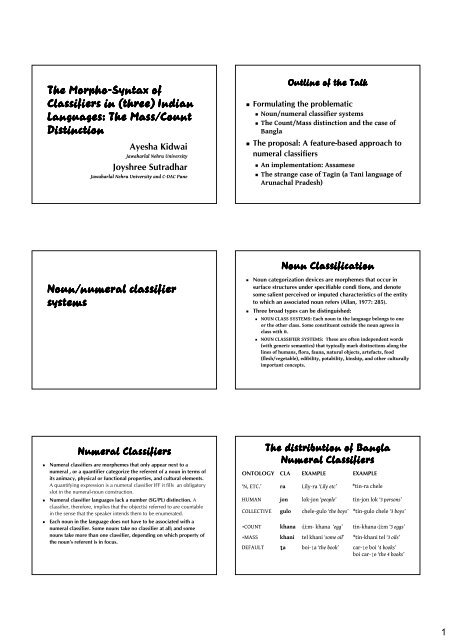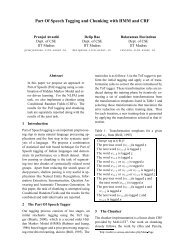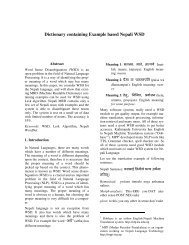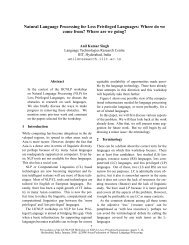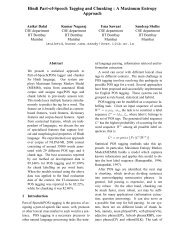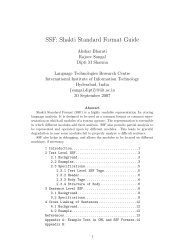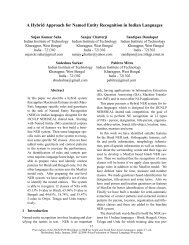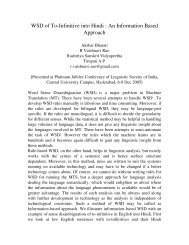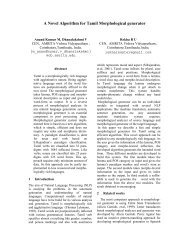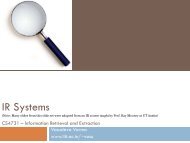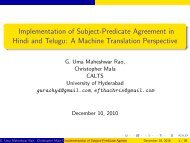The morpho-syntax of classifier systems in Indian languages
The morpho-syntax of classifier systems in Indian languages
The morpho-syntax of classifier systems in Indian languages
You also want an ePaper? Increase the reach of your titles
YUMPU automatically turns print PDFs into web optimized ePapers that Google loves.
<strong>The</strong> Morpho-Syntax <strong>of</strong>Classifiers <strong>in</strong> (three) <strong>Indian</strong>Languages: <strong>The</strong> Mass/CountDist<strong>in</strong>ctionAyesha KidwaiJawaharlal Nehru UniversityJoyshree SutradharJawaharlal Nehru University and C-DAC PuneOutl<strong>in</strong>e <strong>of</strong> the Talk Formulat<strong>in</strong>g the problematic Noun/numeral <strong>classifier</strong> <strong>systems</strong> <strong>The</strong> Count/Mass dist<strong>in</strong>ction and the case <strong>of</strong>Bangla <strong>The</strong> proposal: A feature-based approach tonumeral <strong>classifier</strong>s An implementation: Assamese <strong>The</strong> strange case <strong>of</strong> Tag<strong>in</strong> (a Tani language <strong>of</strong>Arunachal Pradesh)Noun/numeral <strong>classifier</strong><strong>systems</strong>Noun ClassificationNoun categorization devices are morphemes that occur <strong>in</strong>surface structures under specifiable condi tions, and denotesome salient perceived or imputed characteristics <strong>of</strong> the entityto which an associated noun refers (Allan, 1977: 285).Three broad types can be dist<strong>in</strong>guished:NOUN CLASS SYSTEMS: Each noun <strong>in</strong> the language belongs to oneor the other class. Some constituent outside the noun agrees <strong>in</strong>class with it.NOUN CLASSIFIER SYSTEMS: <strong>The</strong>se are <strong>of</strong>ten <strong>in</strong>dependent words(with generic semantics) that typically mark dist<strong>in</strong>ctions along thel<strong>in</strong>es <strong>of</strong> humans, flora, fauna, natural objects, artefacts, food(flesh/vegetable), edibility, potability, k<strong>in</strong>ship, and other culturallyimportant concepts.Numeral ClassifiersNumeral <strong>classifier</strong>s are morphemes that only appear next to anumeral , or a quantifier categorize the referent <strong>of</strong> a noun <strong>in</strong> terms <strong>of</strong>its animacy, physical or functional properties, and cultural elements.A quantify<strong>in</strong>g expression is a numeral <strong>classifier</strong> IFF it fills an obligatoryslot <strong>in</strong> the numeral-noun construction.Numeral <strong>classifier</strong> <strong>languages</strong> lack a number (SG/PL) dist<strong>in</strong>ction. A<strong>classifier</strong>, therefore, implies that the object(s) referred to are countable<strong>in</strong> the sense that the speaker <strong>in</strong>tends them to be enumerated.Each noun <strong>in</strong> the language does not have to be associated with anumeral <strong>classifier</strong>. Some nouns take no <strong>classifier</strong> at all; and somenouns take more than one <strong>classifier</strong>, depend<strong>in</strong>g on which property <strong>of</strong>the noun’s referent is <strong>in</strong> focus.ONTOLOGY‘N, ETC.’HUMANCOLLECTIVE+COUNT+MASSDEFAULT<strong>The</strong> distribution <strong>of</strong> BanglaNumeral ClassifiersCLArajongulokhanakhaniʈaEXAMPLELily-ra ‘Lily etc’lok-jon ‘people’chele-gulo ‘the boys’ɖi:m- khana ‘egg’tel khani ‘some oil’boi-ʈa ‘the book’EXAMPLE*t<strong>in</strong>-ra chelet<strong>in</strong>-jon lok ‘3 persons’*t<strong>in</strong>-gulo chele ‘3 boys’t<strong>in</strong>-khana ɖi:m ‘3 eggs’*t<strong>in</strong>-khani tel ‘3 oils’car-ʈe boi ‘4 books’boi car-ʈe ‘the 4 books’1
Assamese CLA: DistributionalPropertiesONTOLOGY‘N, ETC.’HumanCollective+Count+MASSDEFAULTCLAhotjan, janietcbur,bilaakkhanetckh<strong>in</strong>itaa, to,tiEXAMPLEDeka-hot ‘Deka etc’manuh-jon ‘the man’lora-bur ‘the boys’kitaap- khan ‘the book’tel kh<strong>in</strong>i ‘some oil’lora-to ‘the boy’*e-to lorae-ta lora ‘a boy’*lora-taaEXAMPLE*t<strong>in</strong>i-hot loraat<strong>in</strong>i-jan manuh ‘3men’*t<strong>in</strong>i-bur lora ‘3 boys’t<strong>in</strong>i-khan kitaap ‘3books’*t<strong>in</strong>i-kh<strong>in</strong>i tel ‘3 oils’sari-ta kitaap ‘4 books’kitaap sari-ta ‘the 4books’Assamese CLA: Distributional Properties Assamese CLA can bemapped to these 4semantic classes. All [+QNT] CLAs moveto Num. Moved CLA along withNum/Q yields [-def<strong>in</strong>ite]<strong>in</strong>terpretation, while NPpre-pos<strong>in</strong>g over Numyields [+def<strong>in</strong>ite]<strong>in</strong>terpretation.hotjanburkhankh<strong>in</strong>itoCUM±-±-±±QNT-+-+-±HUM++±-±±ANM+-±-±±Classifier Rais<strong>in</strong>gClassifier rais<strong>in</strong>g is triggered by a [+QNT] and[+def<strong>in</strong>iteness] feature value.Strong quantifiers like sɔb, kimaan, ɔtɔ, gutei attract[±CUM, ±QNT, ±ANM, ±HUM] <strong>classifier</strong>s.Indef<strong>in</strong>ite quantifiers like kei requires another Indef<strong>in</strong>iteCLA maan to get right cliticised to the +QNT Classifier.Weak quantifiers kisu, ɔlɔp, ɔkɔn do not attract a <strong>classifier</strong>that is valued for cumulativity or quantization. Only theIndef<strong>in</strong>ite CLA maan gets attached to it. But it is not basegenerated with the Head N like other CLA.Quantifier Distribution <strong>in</strong> AssameseQxakalo‘allall’guteikei ‘somesome’Kisu‘somesome’Ŧlɔp(few)CUM±±±++HUM+±±±-QNT-±±--ANM+±±±-CLAxakalo-bur manuhxakalo-kh<strong>in</strong>i manuhgutei-kh<strong>in</strong>i manuhgutei-khan kitaapkei-jan-maan manuhkei-taa-maan aamkei-jan manuh ‘howmany man’Kisu-maan manuhŦlɔp-maan paaniLight Nouns <strong>in</strong> Assamese &Quantification<strong>The</strong>re is a group <strong>of</strong> nouns <strong>in</strong> Assamese which neitheroperate at purely functional or lexical level.Relation between quantification and def<strong>in</strong>itenessmark<strong>in</strong>g <strong>in</strong>volv<strong>in</strong>g these k<strong>in</strong>d <strong>of</strong> nom<strong>in</strong>al expressionsneeds highlight<strong>in</strong>g.Assamese nouns, unlike their Bangla counterpart,conta<strong>in</strong>s a strong formal feature which make themmove to Q-head and Spec <strong>of</strong> QP for check<strong>in</strong>g itsspecificity feature (examples <strong>in</strong> next slide).Comparison <strong>of</strong> Assamese and BanglaBangla ek glas jol [-def] du glas jol [-def] * jol-glas * jol du-glasAssamese ek-koloh paani [-def] du-koloh paani [-def] paani koloh [+def] paani du-koloh [+def]5
Thank Youayesha.kidwai@gmail.comjoyshree@gmail.com6


